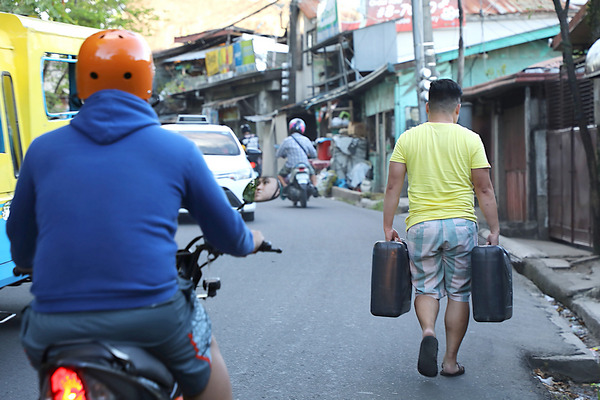WATER SUPPLY DOWN

The Metro Cebu Water District (MCWD) is advising its consumers to conserve water as some areas in Cebu and Talisay cities start experiencing water service interruptions like Capitol Site area in Cebu City. The MCWD had to reduce water production to ensure enough potable water for consumers in both cities.
MCWD asks consumers in Talisay, Cebu cities to conserve water; weather bureau doesn’t expect rains until May
Jairah Mae Caminero hasn’t gotten enough sleep lately.
Instead of the regular eight hours, the 19-year-old college student’s bedtime has been reduced by two hours since Friday.
“I usually sleep at 10 p.m. but I have to wake up as early as 4 a.m.,” she said in an interview.
In the past five days, Caminero and her boardmates had to be up early in order to store enough water because the faucet started drying up at 6 a.m. up to 6 p.m.
“If I don’t wake up at 4 a.m., we won’t have enough potable water for us to take a bath, wash our clothes and dishes,” said Caminero, a native of Palompon town in Leyte, who is renting a room in an apartment in Barangay Mabolo, Cebu City.
And the water interruption may just get worse.
The Metropolitan Cebu Water District (MCWD) on Tuesday urged residents in the cities of Cebu and Talisay to conserve water due to the continuing decline in the water levels in Jaclupan Watershed and Buhisan Dam.
Charmaine Kara, MCWD spokesperson, said in a phone interview that their production department decided to reduce water production to ensure that there would be enough potable water for their consumers from both cities.
From an average of 33,000 cubic meters per day, Jaclupan Watershed in Talisay City is now producing 30,000 cubic meters of water per day.
On the other hand, Buhisan Dam in Cebu City supplies potable water at a rate of 4,000 cubic meters per day or 2,000 cubic meters less than its average production of 6,000 cubic meters.
With reduced water production, Kara said some portions of Cebu City and all parts of Talisay City would experience water interruptions.
“This means that we will limit our service hours. Normally, we have water for 24 hours but now, we will stop water production at, let’s say at dawn, since the demand is relatively low. In this way, we can still store water to last until the rainy season starts,” she said.
Jaclupan Watershed supplies potable water to the entire Talisay City, which has a population of over 227,000, and portions of southern Cebu City such as barangays Bulacao and Pardo.
Buhisan, on the other hand, is the source of potable water for residents and establishments in downtown and uptown areas of Cebu City, including Barangay Mabolo.
“This is why we’re now urging everyone to conserve water by using recycled water to water your plants, to flush (the toilets) or to clean your garage. You can save up to 10 gallons of water,” Kara said.
The decrease in water supply in the Jaclupan Watershed and Buhisan Dam is attributed to insufficient rain on the onset of the summer heat.
Unfortunately, the Philippine Atmospheric, Geophysical and Astronomical Services Administration (Pagasa) doesn’t expect any rain this month.
The earliest for rains to occur would be in May, said Engr. Al Quiblat, chief of the Pagasa-Mactan bureau.
“Rainfall plays a significant role in our water supply. So naturally, it will decrease because of the insufficient rain we’re experiencing,” he explained.
The weather bureau declared the start of summer last April 10 and would last until the rainy season in June.
A data from Pagasa revealed that April is the driest month with a slim chance of rain.
So far, Pagasa-Mactan recorded just 41.3 millimeters of rainfall in April or below the expected average of 50 millimeters.
The highest heat index in Cebu was recorded at 41 degrees Celsius at 1:40 p.m. on Monday and last April 14, said Nedz Salatrero, weather specialist of Pagasa-Mactan.
On Tuesday, the heat index in Cebu registered at 40 degrees Celsius.
The heat index or human discomfort index is the actual temperature felt by the body based on air temperature, humidity and the surrounding environment.
Because of the scorching temperature, water demand was expected to increase.
But Kara said that the insufficient rains in Cebu had not affected the supply of groundwater wells and bulk water.
“Dry season affects initially our surface water source. Majority of MCWD’s sources is still groundwater,” said Kara.
She said MCWD was doing everything to ensure steady water supply to residents and establishments in Metro Cebu.
Kara said the Jaclupan Watershed and Buhisan Dam comprised only 15 percent of the total water supply in Metro Cebu.
“There’s no possibility for our surface water sources to be completely dried up. The good thing this year is that there’s no El Niño phenomenon. Of the 230,000 cubic meters per day we produce, 53 percent are sourced from our groundwater wells and 32 percent are from bulk water supplies,” she added. / with PIT Intern Glazelle Bless Viter
Disclaimer: The comments uploaded on this site do not necessarily represent or reflect the views of management and owner of Cebudailynews. We reserve the right to exclude comments that we deem to be inconsistent with our editorial standards.




